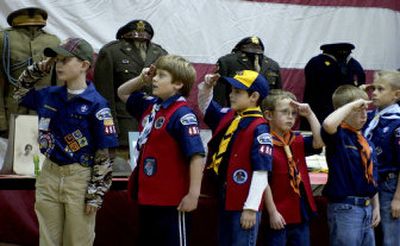Remembering heroes

Hugh Boyd would have loved the Veterans Day assembly at Freeman Elementary School. The first-graders’ heartfelt pledge of allegiance, the fourth-graders slowly but steadily playing the “U.S. Army Anthem” on their recorders, was worth fighting for.
Boyd wasn’t there. The U.S. Army Air Force Lieutenant, who flew cargo planes across the Himalayas during World War II, died years ago but his uniform was on hand along the with a short story of his 95 missions over 530 deadly miles of mountains known as “The Hump.”
“I think I started to bail out over the Hump three times,” Boyd said. The long-ago quote taken from the book “Hangar Tales” lay beside his drab green dress uniform. “I was never crazy about jumping in those mountains.”
There were 12 uniforms of soldiers, mostly from Spokane, on display at the school, each pinned with medals and a brief history of the men and women who fought for their country. Tim Smetana, a military history collector who takes the display to schools every Veterans Day, said he wanted to expose Freeman students to real heroes.
“Those guys,” Smetana said of the veterans. “My gosh, if everyone one of them wrote down their experiences, our generation would have so much to read about true heroes instead of basketball players and football players.”
Students who toured the exhibit learned that Boyd was just a kid from rural Spokane, much like themselves, who had an interest in flying and alpine skiing.
When World War II broke out, Boyd set out to join the ski troops, but headed for the Air Corps after hearing the Army needed pilots. The Japanese had invaded China and controlled the entire China coastline during World War II. To get supplies to its Chinese allies, American and British pilots would fly combat cargo missions over the Himalayas, the world’s highest mountain range. Nearly 1,000 men and 600 cargo planes were lost flying the Hump, but Boyd survived.
“You hear it all the time, but it’s important to understand the sacrifice they made for us,” said Tracia Johnson, a Freeman mom who toured the exhibit after the assembly.
Some of the stories behind the uniforms are shorter than Smetana would like. The uniforms often become available only after a veteran has died; Smetana has acquired much of his collection through estate or garage sales. Sometimes surviving family members know very little about their loved one’s service.
Melville F. Colby, a sailor from Spokane, was represented by his deep-blue uniform and an elaborate certificate of service, a diploma really, stating that Colby “served in the Armed Forces of the United States of America against nations which ruthlessly sought to destroy the sacred privileges of American liberty, justice and equality.”
Smetana started his collection 20 years ago while living in Oklahoma. His uncle, A.J. Smetana had died and Tim Smetana’s aunt bequeathed her husband’s leather bomber jacket to her nephew.
A.J. Smetana was a tail gunner in a bomber that flew missions over Europe during World War II. Just an 18-year-old kid from Oklahoma when he joined the Army Air Force, A.J. Smetana was credited with shooting down a German Messerschmitt fighter during the war, Smetana said. American bombers took a lot of flak flying over Europe. After one mission, A.J.’s plane, the “Bigas Bird,” was so badly shot up, its landing gear failed and the crew had to do a belly land when they returned to their base in England.
When Smetana speaks of his uncle and the other soldiers who once occupied the uniforms he displays, you can hear the reverence in his voice. He never served in the armed forces and sees the display as a way to honor those who did. He’s a stickler for detail, even setting up a fan to ripple the 30-foot by 40-foot American flag he uses as a backdrop.
Once the show starts, he fades into the background, only stepping forward to answer questions. The last he’d want is for someone to mistake him for a hero simply because he’s brought the uniforms to light.
“It’s not about me,” Smetana said. “It’s about the kids here at Freeman and heroes who served our country.”